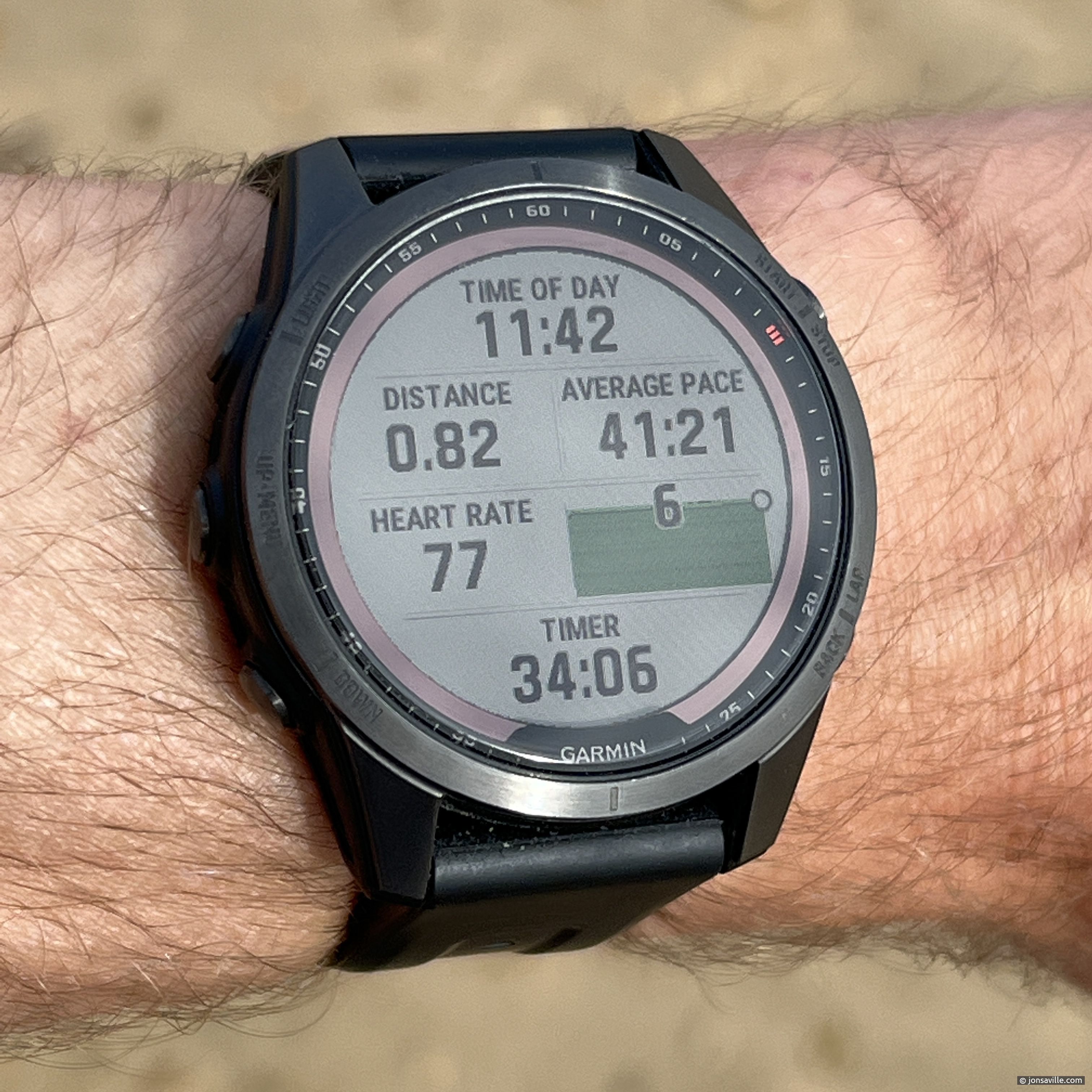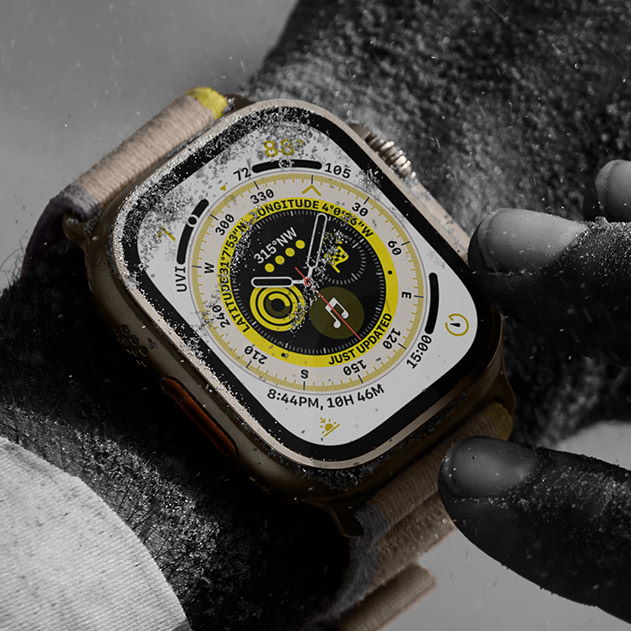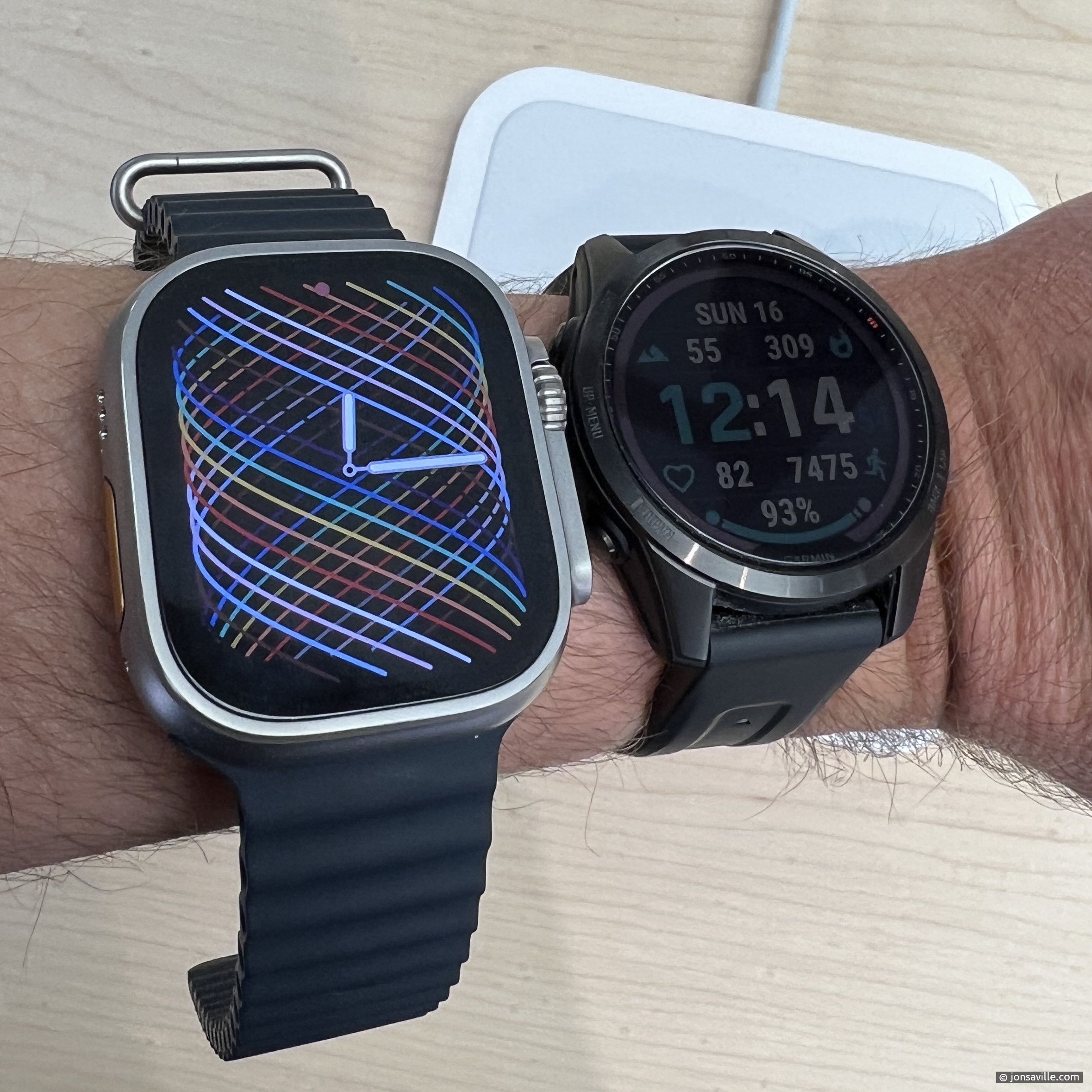
After a lot of research and procrastination, I finally bought a sports watch earlier this year. Pictured here, it’s a Garmin Fenix 7S Solar (black). I’m very happy with it, but was curious when rumours of Apple’s new sports watch began to surface.
Update 02 October 2022 - early reviews have largely confirmed the positive and negative points I discuss in this post, and most seem to agree that the Ultra is both pretty big, and aimed primarily at smartwatch users who want an upgrade from the Apple Watch in terms of battery life and rugged design.
A teardown by iFixit shows the battery capacity at 2.1 Wh - identical to Garmin’s biggest watch, the 51mm Fenix 7X, which runs a month of normal use and somewhere around 100 hours of full GPS. My 42mm Fenix 7S battery is 42% of the Ultra’s capacity and has similar GPS endurance - as you might expect, given the different experience the Ultra is offering.
Original article continues:
I am not a fitness fanatic. I’ve started exercising more regularly over the last few years as my age and weight began to rise. I try to do an hour every day, alternating between road bike, stationary bike, and walking here in (flattish) Rutland. I also do longer hikes, sometimes with my sister, who is ticking Munros off at a frightening rate.
Having relied on my iPhone for a long time, I wanted something on my wrist that I could glance at and that was specialised for the job. My criteria were fairly simple:
Solid heart rate monitoring.
Accurate GPS support.
All-day battery on full GPS. At least a week of battery with casual use.
Small enough to fit my narrow wrists.
Physical design and OS both optimised for outdoor use.
A functional way of exporting and managing activity data.
Nice to have: onboard maps. On-watch maps are by necessity a compromise, but can be useful for sanity checking.
Not needed: smartwatch features. I try to minimise distractions, and having notifications pinging off my wrist every few minutes is not conducive to that goal.
Not needed: music. The Fenix supports bluetooth headphones and music syncing, but it’s a faff, and is a feature best left to the phone.
The Fenix 7S is top of Garmin’s line, but I didn’t want to regret my purchase for want of a missing feature. I could (and perhaps should) have bought the Sapphire edition, which has multiband GPS (which Apple make a great deal of noise over) and a titanium case, but both would be overkill for me.
In general, the Fenix has met my needs. It’s reliable, accurate, frugal with battery, and Garmin Connect is excellent. The 42mm case fits my wrist well and the supplied strap is comfortable. It has many activity profiles which work well, especially for GPS-based and cardio activities. It’s very easy to do things like plot a hiking route on the desktop and have it sync automatically with the watch. Finally, I have Garmin speed and cadence sensors linked to it for cycling, and the ANT+ connection is reliable and quick.
Outdoor practicalities
I think we can take most items on the list above as a given for the majority of sports watches. It’s perhaps worth talking a bit more about how a watch can be designed for outdoor activities.
Needless to say, outdoor activities take place in less than ideal circumstances for manipulating a complicated piece of technology. There is weather, clothing and fatigue to consider.
Information should be clearly presented at a glance. Ideally, the layout should be customisable by the user.
For the most part, the interface should use physical controls. Touchscreens are useless when you have cold fingers in gloves.
It should be difficult to change the operation of the watch without intent. This means being able to disable the touchscreen and even lockout physical buttons.
The Fenix meets all of these requirements, and includes the ability to lock the physical buttons so you need a long-press to enable them. I turned this on after a couple of incidents where changing a coat during a hike caused an accidental button-press. I wish you could enable this feature per activity, but at least it’s available.
The Apple Watch Ultra

As I write this, no-one has published a full review of the Apple Watch Ultra and a lot of details are unknown. Also, clearly, people’s needs and tastes differ markedly and these are just my opinions.
That being said, I have some thoughts. Although I’ve never been in the market for a pure smartwatch, I’m interested in bringing technology to my hobbies. Things I like about the Ultra:
Robust design. The titanium/sapphire combination looks solid and practical, and the flat screen allows for a screen protector. Although I wouldn’t describe the design as stylish, it’s better than the dorky lozenge of the classic Apple Watch.
High-res OLED screen. Garmin has the Epix watch which is similar to the Fenix except for its AMOLED screen. However, it’s only available in a 47mm case.
Opinions differ on screen technology. The transflective screen of the Fenix is clearly not as beautiful as a high-res OLED, and it can be difficult to read indoors. On the other hand, it is very clear outdoors and is a big factor in the Fenix’s battery life.
Concerns I have about the Ultra:
Reliance on touchscreen. It’s not clear whether you can disable the touchscreen (or buttons) against accidental activation.
Seems big. This is difficult to appreciate without trying it on, but I think it would be too big for my wrist.
Going by the released specs and some rough measurements, the Apple Watch Ultra appears to be 40% bigger by volume and 45% heavier compared with the Fenix 7S Sapphire (also titanium). Obviously I’m comparing the Ultra with the smallest Fenix, but this seems relevant when looking at the similar battery performance. What’s taking up this extra space? I’m guessing a bigger battery to power the smartwatch features and screen, and the cellular modem. The Fenix 7S has a 0.87Wh battery according to this teardown, and I can’t wait to see a teardown of the Ultra. Update: here's one by iFixit!
- Battery life seems poor given its size.
Even with the extra space, Apple are being very cagey about battery life. The quoted 36 hours of “All-day battery life” includes no GPS activities. “Multi-day adventure battery life” gives you an estimated 2.5 days of reduced smartphone usage and 15 hours of GPS - but all with a reduced GPS and heart rate sampling frequency.
We’ll have to wait for some real-world testing to see what that means in practice. But extrapolating, this perhaps translates to a solid day of full GPS before a recharge is needed - similar to the Fenix 7S. It’s not meaningful to compare the non-GPS battery life of the Ultra to the Fenix as they are doing very different things.
Lack of built-in mapping. I realise that Apple watches have an app ecosystem that is expected to round out their feature sets. Nonetheless, the Fenix’s includes a good mapping suite out of the box. You can import or plot a route on the Garmin Connect desktop or mobile apps, import it to the watch, and use that data for activities on the supplied worldwide topo maps. Those maps are not perfect, but they feel to me like an important part of an (expensive) sports watch package.
The screen designs we have seen are a hot mess of tiny informatics. This is presumably easily fixed and we can expect to see more glanceable UI designs soon.
No ANT+ or Bluetooth sensor compatibility mentioned. Pairing sensors to the phone seems to be the preferred route in Apple world, but to me this just underlines that the Apple Watch is not a standalone solution.
Who is the Ultra for?

I think that the Ultra is designed for smartwatch users (with larger wrists) in the Apple ecosystem who want a more rugged Apple Watch with better outdoor performance. The Ultra is a solid attempt to meet those needs.
Apple are pushing this as a watch for extreme adventurers, but I think that is largely marketing hype. That is not to say that some extreme sports types won’t use this watch - I’m sure they will. But for longer and more remote expeditions I expect most people will stick to sports watches designed from scratch for that purpose, and which have fewer dependencies on a tethered phone.
Update 16 October 2022 - I got the opportunity to wear the Apple Watch Ultra at an Apple Store, and largely confirmed my early impressions. The watch is chunky - partly thanks to its overall dimensions. But it’s the profile of the watch which contributes most to the sense of size, with a prominent bulge running around the case. Most watch cases taper towards the screen, so despite the Fenix 7S being the same height it looks tiny next to the Ultra.